Entity-based competitor analysis: An SEO’s guide
Here’s how a competitor entity analysis can help you pinpoint content opportunities and build topical authority to stay ahead of competitors.
Entity competitor analysis is the key to unlocking higher rankings and staying ahead of competitors. By understanding Google’s Knowledge Graph and entity relationships, you can strategically optimize content for increased topical authority and relevance beyond keyword-centric pages.
Entity-based competitor analysis isn’t about mimicking existing content. It’s about identifying strategic gaps where you can establish topical authority, future-proofing your site against algorithm updates that increasingly favor deep subject matter expertise.
This article will:
- Explain why entities are key to a strong SEO strategy.
- Show you how to use a Python script with an NLP (natural language processing) tool.
- Help you reveal unique entities your competitors target and the ones Google associates with your niche.
The result? A roadmap of the entities Google uses to understand your space, plus insights into where your site stands against the competition.
Create content strategies in the language Google thinks
Before diving into the reasons for entity analysis, let’s clarify an important idea: modern search engines “think” in terms of entities.
Entities are the building blocks of how search engines understand the world. Using entities in your content provides clues to help search engines accurately interpret your website and connect it to the right searches.
What does it mean that search engines think in entities?
Search engines have come a long way from focusing solely on matching individual keywords within a query.
Think of it like this: In the past, if you searched for “jaguar,” a search engine would primarily look for websites containing that exact word. The result could be a mix of pages about the animal, the car company or other less relevant uses of the term. Understanding the user’s true intent was difficult.
With entity thinking, Google builds a vast knowledge base – it’s like a giant encyclopedia of real-world things, concepts and the relationships between them.
Google analyzes a search query like “jaguar” and considers related entities like “habitat,” “predators” or “speed.” This helps it figure out the context and show the most relevant results, even if a website doesn’t overuse the keyword “jaguar.”
Let’s say a user searches for “healthy recipes with chicken.” Google doesn’t just look for that exact phrase. It can recognize related entities like “vegetables,” “low-carb” or “slow-cooker.” This means more pages are now eligible to rank for a given search, even if they don’t use the exact search terms.
This change in entities favors large guides that are informative and touch on many entities associated with a subject. Sites incorporating these broader entities are more likely to match the user’s needs, even if they never use the original search term word-for-word.
Dig deeper: Entities, topics, keywords: Clarifying core semantic SEO concepts
The role of entities in linking together subject matter
Additionally, entity analysis helps you optimize your internal linking in a way that resonates with search engines that “think in entities.”
While traditional linking might connect pages using basic keywords, entity linking goes deeper. It allows you to connect pages based on the underlying concepts and their relationships.
This strengthens the relevance of each page to search engines, helping them understand the full scope of information you offer.
Imagine it as building a web of knowledge, not just a scattered collection of keywords. Using the same entities makes it much easier for Google to grasp your website’s focus quickly.
The key takeaway is this:
Search engines strive to think like we do. Keywords are still important, but demonstrating a nuanced understanding of the entities and relationships within your niche sets your content apart and signals to Google that you’re a reliable source of information.
The easier it is for Google to understand your content (disambiguate) and the better it matches what Google sees as important in your niche, the higher your content will rank.
Now let’s get into why it is worth your time to analyze your competitors’ entities.
Why not just do a competitor keyword content gap?
Entity analysis offers several key advantages for your SEO strategy. It helps you expand your reach, understand context and uncover hidden opportunities that a solely keyword-focused approach might miss.
Here’s how it differs from a traditional keyword analysis:
- The granular vs. the big picture
- Think of keywords as individual bricks, while entities are the entire building. An entity competitor analysis offers a higher-level view of the subject matter covered by a website.
- Analyzing entities and their relationships can reveal entire semantic networks of keyword opportunities. This allows you to identify areas to outsmart the competition by filling content gaps.
- Keywords lists vs. topic mastery
- While a keyword competitor analysis might give you a list of terms to target, entity analysis delves into the core of a topic. It reveals the related concepts, subcategories and influential figures within your niche.
- This enables you to create content demonstrating a truly comprehensive understanding, a key signal of authority for search engines. This can mean identifying content that is important to cover but that your site may not rank for.
That said, entity competitor analysis isn’t a supplement to traditional competitor research, but it can serve as a step to organize the types of keywords that competitors go after.
Here’s where it fits within your larger SEO strategy:
- Strategic focus: Entity analysis helps you pinpoint where your competitors have a strong topical presence and identify areas where your site might need development.
- Content planning: Identify the “umbrella” of related entities, revealing opportunities to build content structures that reflect how users and search engines understand your topic.
- Revealing true topical strength: A competitor might enjoy a topical authority boost from various content, not just search-optimized articles. Entity analysis can help uncover less obvious resources, such as in-depth guides, videos or community forums. This gives you a more accurate understanding of their true edge and the gaps you need to fill.
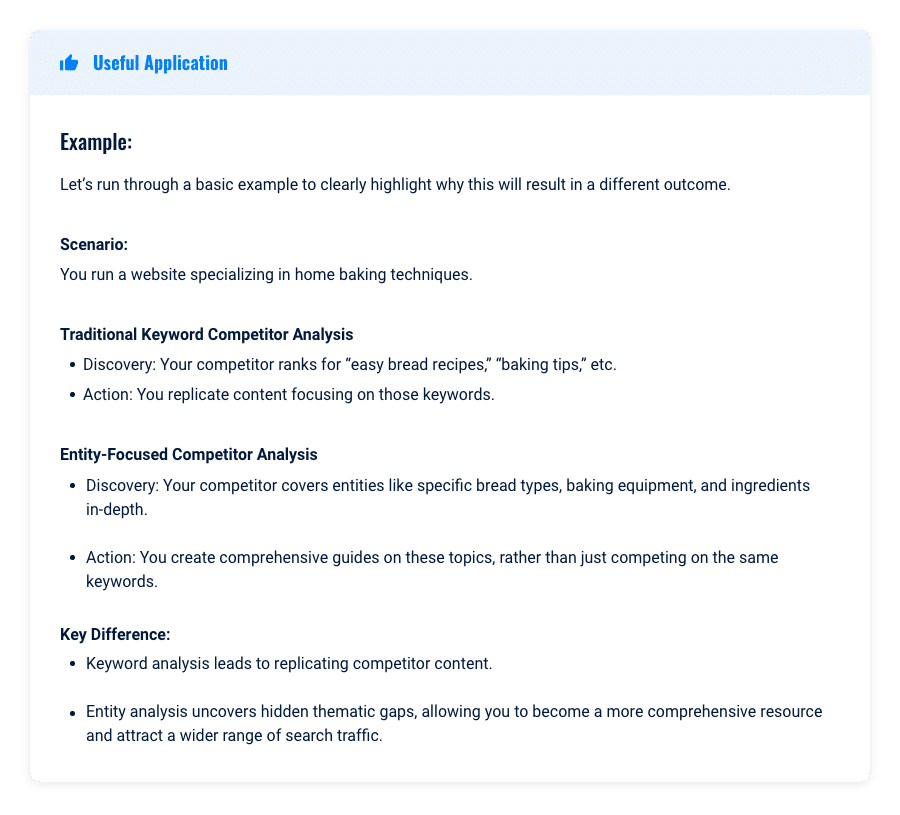
What is this competitor audit trying to uncover?
Your entity audit provides laser-sharp insights into where your content could be falling short compared to competitors and how to take action. Here’s what your report specifically uncovers:
- Precise topical gaps: By analyzing title tags, URLs and meta descriptions, your report identifies the primary entities your competitors focus on for each page. This goes beyond general keyword lists and reveals where they are establishing topical authority that your site may be missing.
- Actionable content opportunities: Your report doesn’t just tell you what’s missing; it shows you exactly how competitors address those entities. Seeing competitor URLs associated with each entity gives you a clear starting point to develop your own improved or expanded content.
- Strategic structure guidance: How your competitor titles and links their pages around entities gives you valuable clues about how to organize your site. You can identify high-level content ‘hubs’ that you’re missing as well as potential internal linking opportunities.
The key advantage: This hyper-focused entity analysis allows you to identify the topics you need to cover and gives you a roadmap for creating content that resonates with search intent and user expectations within your niche.
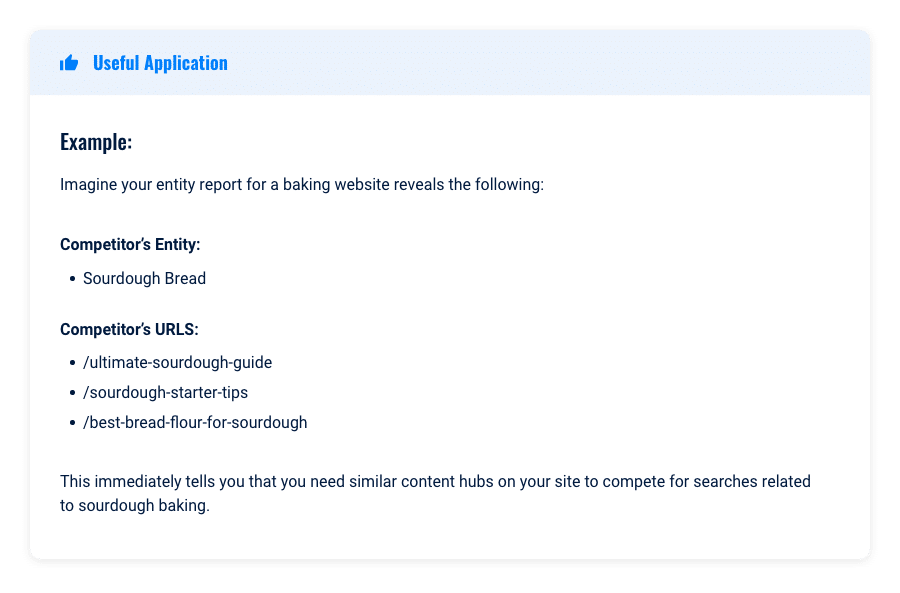
Why can linking with entities be more powerful than just keywords?
Disambiguation: Many words have multiple meanings (consider “Python” as a programming language vs. a snake). Entities, especially when linked to Knowledge Graph data, eliminate this ambiguity.
- Relationships: Entities carry more information than keywords alone. A link with “Tim Berners-Lee” not only implies the topic “Web inventor” but also hints at potential relationships with “HTML,” “HTTP,” etc.
- Entity salience: Entity salience is a key metric, likely factored into search algorithms, that determines how prominently a particular entity features within your content. Optimizing for entity salience is critical for signaling topical relevance. Search engines may increasingly calculate an “entity salience” score for a page – how prominently a specific entity and related entities feature within the content. Entity-based linking plays a direct role in this.
Let’s run our tool
There’s no need to be intimidated by Python code or the Colab environment – getting started with this tool is surprisingly easy.
Remember, we’re not just chasing a list of entities; we’re building a strategic roadmap for your website’s success.
Prerequisites
- A TextRazor API key: Sign up for a free trial or paid plan at TextRazor to obtain an API key. The free API key is limited to 500 API calls per day.
- Any crawling tool:
- Ahrefs, Screaming Frog or similar SEO crawler: Ensure it can export data as a CSV file.
- Custom web scraper (if comfortable with coding): Python libraries like BeautifulSoup or Scrapy can be used.
Process
Step 1: Crawl your website(s)
- Use your chosen crawling tool to extract the following data for each URL:
- URL: The full web address of the page.
- Title tag: The content of the HTML
<title>tag. - Meta description: The content of the
<meta name="description" content="...">tag.
- Export as CSV: Save the crawled data as a CSV file.

Step 2: Ensure correct column headers
- Open your CSV file (using a spreadsheet program or text editor).
- Verify your CSV file has the following column headers (or adjust the code accordingly). Update the values at the top to map to the column titles you are using:
url_col(e.g., “Address”): This is the title of your column for the URL.title_col(e.g., “Title 1”): This is the column title for your pages’ title tags.desc_col(e.g., “Meta Description 1”): This is the column title for your pages’ meta descriptions.url_limit = "200": You will be limited by the number of API calls you can make in your Text Razor account to 500 per day.
Step 3: Access the shared Colab notebook
- Colab notebook: Entity_competitor_analyzer.ipynb
- Click the link to open the notebook in Google Colab.
Step 4: Make a copy
- In the top menu, go to File > Save a copy in Drive.
- This will create a copy of the notebook within your own Google Drive.
Step 5: Replace api_key with your TextRazor API key

- In your copy of the notebook, find the line textrazor.api_key = “api_key”.
- Replace api_key with your actual TextRazor API key.
Step 6: Upload your data file
- Click the Files icon on the left sidebar of your Colab notebook. The first file uploaded will be considered your website, while the other ones will be considered competitors. You can upload three websites’ data in total.
- Click Upload and select your CSV file.
Step 7: Run the code
- Click the Run all button to execute all code cells in the notebook.

Output
- The Excel file (“entities_analysis.xlsx”) will be automatically downloaded.
Turning entity insights into action: Your competitive advantage
Your analysis has provided powerful data: a visual breakdown of shared and unique entities, plus detailed spreadsheets. Now, let’s turn this into a strategic roadmap for your website.
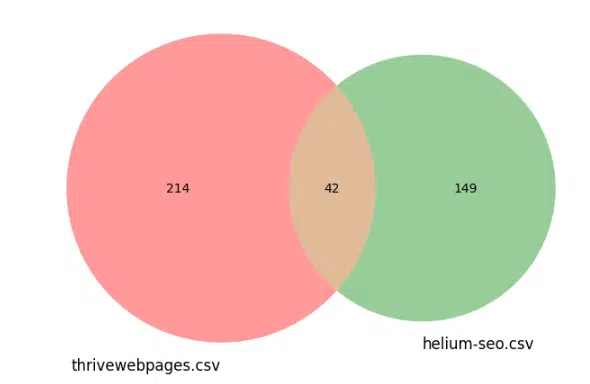
1. Target competitor gaps
- Entity-driven opportunities
- You have a list of pages your competitors rank for, covering entities your site is missing.
- Filter the list only to include the URLs that fit nicely into your industry (e.g., consider removing client-specific case studies).
- Use tools like Ahrefs to see exactly what terms they rank for. This is your untapped content potential.
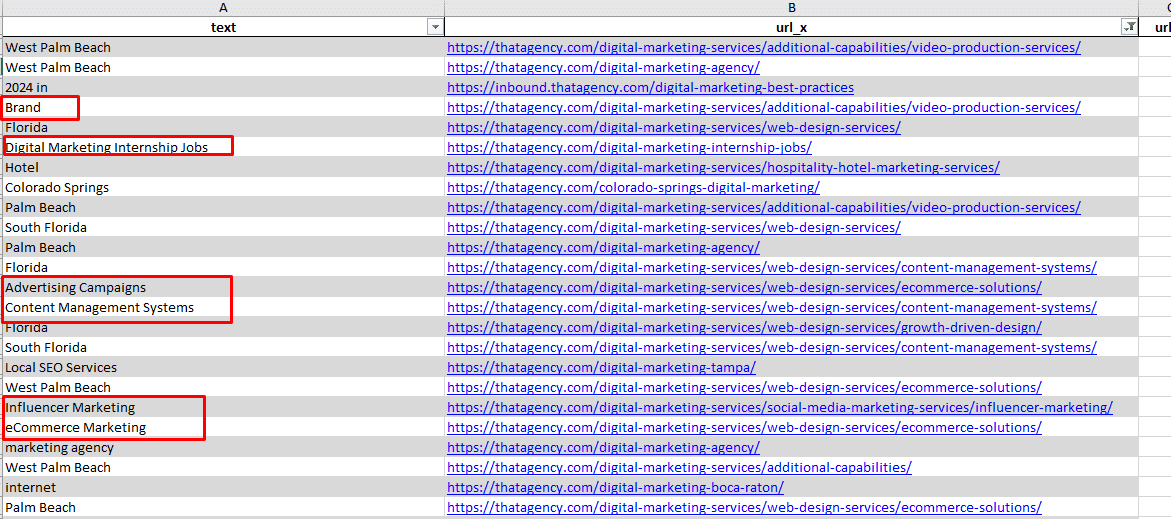
- Expanding your content umbrella
- Identify patterns within the unique entities. These represent broader subject areas where you can excel.
- Use keyword research to expand your content strategy with these “big picture” areas in focus.
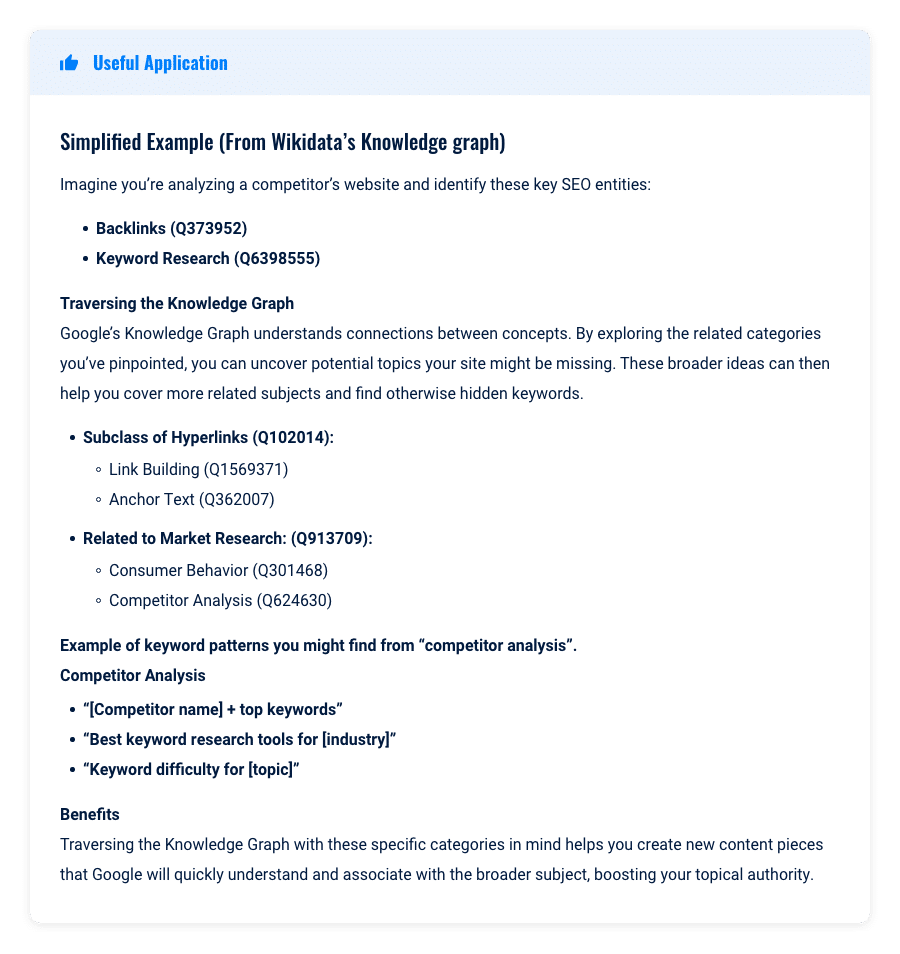
Additionally, if other entities point to specific industries, consider crafting content demonstrating your expertise.
- Use keyword research to pinpoint what people are searching for within these categories and address those questions with valuable content.
- This way, your entity analysis helps you expand your website’s focus to cover the big-picture topics your target audience seeks out.
Dig deeper: An SEO guide to understanding E-E-A-T
2. Speak Google’s language
- Semantic boost: The list of entities Google uses for your niche is pure gold! Use these as internal linking anchors to create rich connections between your content.
- Clarity is key: Treat these entities as synonyms. Replace less specific terms in your existing content with them to signal relevance to Google.
Here’s an example:
- Let’s say your existing title tag is: “Boost Your Online Presence.”
- After running an entity analysis, you might find these relevant entities: “web design” and “local SEO.”
- A revised title tag using entities could be: “Web Design: Boost Your Local SEO”
Note: Always ensure your title tags still read naturally and entice users to click.
Beyond competitor entity analysis: How to make this even more advanced
This competitor audit reveals high-level thematic gaps, but true entity analysis power lies in its granularity.
It has limitations, especially because the highest salient entities are not always represented in the title tag, URL and meta description.
By analyzing entities at the individual page level, you can:
- Reverse engineer competitor success: Dissect pages outranking you to pinpoint the exact entities and their salience contributing to their topical authority.
- Optimize beyond keywords: Identify where to strategically incorporate entities within your content structure (beyond just titles and meta) for maximum relevance signals.
- Semantic internal linking: Strengthen your website’s topical architecture by using entity relationships to guide your internal linking strategy.
You can delve even deeper into competitor analysis by using TextRazor to analyze each of their webpages and store the results in embeddings. This lets you find a complete list of entities and pages unique to them.
While this is a thorough approach, a simpler method like the above often provides enough insight. The exhaustive route can be more expensive and may sometimes lead to less clarity instead of more.
